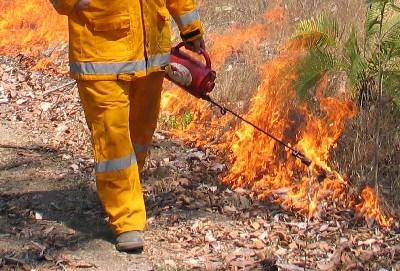Interestingly,
a study in south-eastern Australian forests described a conflict between hazard
reduction and maintenance of biodiversity. Fire intervals of <4 years and 8+
years were respectively recommended; in some habitats concurrent hazard
reduction and effective species conservation may not be achievable (Morrison et
al. 1996). This reveals a deeper, indirect impact on the environment caused by
the dominant culture knowledge system and the values it places upon property and
possessions – increasingly populated bushland areas will most likely be managed
for risk reduction, at the detriment of natural ecosystems.
In the
Australian tropics, fire regimes are perhaps better understood and based upon a
combination of scientific research and traditional knowledge. However, even in
the sparsely populated indigenous lands, fire regimes in modern times are often
not ecologically ideal. Largely due to centralisation and depopulation of the
bush following European colonisation, many remote areas are now left for too
long between burns, resulting in hot, destructive fires. Closer to settlements
fire management is better; however, as people lose dependence upon the bush for
resources, younger generations are becoming ignorant of the correct ways to burn
(Yibarbuk 1998).
In short, current fire management in Australia is
probably far from ideal. With the possible exception of the tropical savannas,
it appears change in fire management has been forced due to safety and
ecological concerns, rather than occurring through a conscious effort to
incorporate other knowledge systems. There is movement away from the
fire-exclusion policies now recognised as dangerous and ecologically damaging,
perhaps hinting of evolution towards more sustainable forms of
management.







Anthony Moore 153588
What is
the Status Quo?
Modern fire management in Australia widely recognises
the importance of utilising low intensity prescribed burns to reduce fuel loads
within bushland areas and lower the risk of wildfire impact on humans (Penman
2007). Despite developing for very different reasons, this style of management
appears to be more closely aligned with traditional indigenous practices.
Indeed, some modern fire management plans implemented in the tropical savannas
and arid regions are specifically modelled upon traditional fire regimes
(
Department of the Environment, Water, Heritage and the Arts 2007,
Kakadu Board of Management and Parks Australia 1998). However, experts maintain that in most
areas, particularly the temperate Eucalypt forests, the fuel accumulation rate
still greatly exceeds the rate of fuel removal or treatment – a key factor
leading to extreme fire events (Bushfire CRC 2006).
Double click
to edit
The status quo
in Australian fire management appears to be evolving from old fire-exclusion
policies towards some semblance or at least recognition of indigenous regimes,
but apparently only at a rate which does not cause inconvenience or negative
economic impacts. For example, fire risk analysts recommend that prescribed
burns be much more frequent and widespread than presently used, however
resources for this are often limited (Bushfire CRC 2006). Further, land uses
such as forestry, tourism and mining may also determine that burns are not
performed when required, influencing the effectiveness of fire management.




























